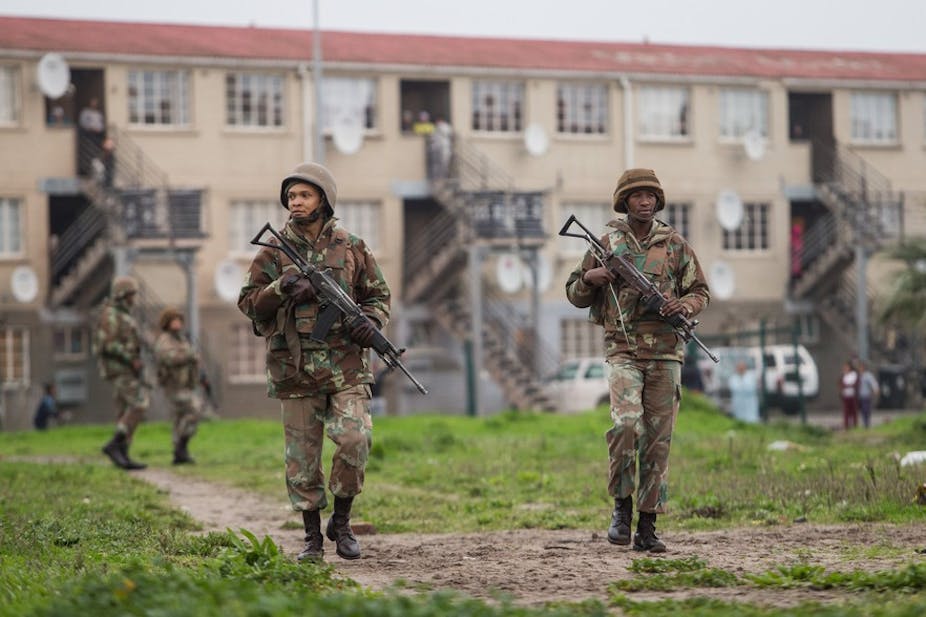The South African government has taken a decision to deploy members of the South African National Defence Force to areas that have been ravaged by gang violence.
At least the deployment of the army shows some commitment by government to address the dire security problems these communities face. But it’s too little too late. It constitutes nothing more than simply sticking band aid on a festering wound.
The arrival of the soldiers has made headlines in the country. But will they make any difference?
In the short term they are likely to silence some of the guns. But they are unlikely to net any of the important kingpins behind the violence. Firstly, many of them don’t live in the neighbourhoods in which they conduct their business. Secondly, those who were living there would have decamped long before the soldiers arrived.
Lasting solutions to gangsterism and organised crime on the Cape Flats require a much more comprehensive approach than has been put into action. It requires a plan that pulls together various government agencies as well as different departments. The country in fact has a framework for joint action. Outlined in the Department of Defence’s review in 2015, it lists how the approach should be implemented.
Unfortunately, four years on, no progress has been made to structure this kind of approach. This pertains not only to issues of future force design and command-and-control, but to the need for better coordination in the sharing, storing and analysis of information and intelligence among all the departments involved.
This coordination is not happening. Soldiers, for instance, collect and process data into actionable intelligence to inform when and where to launch attacks. For their part, the South African Police Service, the Department of Correctional Services and the judiciary collect data and information to translate it into evidence that could be presented in courts of law. These diverse organisational end states limit the chances for lasting success. Unless all the efforts are focused, continually managed and controlled to achieve mutual support, none of the institutions can act effectively.
This won’t be easy. I know this from firsthand experience. As a serving South African Army officer who was deployed with members of the police in cordon and search operations during the 1990s, I can attest to the difficulties experienced in coordinating activities among state departments and agencies.
A joint approach tested, then abandoned
In the 1990s joint, interdepartmental and inter-agency structures were established from local, to provincial to national level. These bespoke structures were tailored to serve the operations and intelligence communities from tactical, to provincial to national levels that played a vital role in the collection, processing and dissemination of the intelligence collected.
Intelligence officers were also deployed in specific areas for extended periods of time which provided them with opportunities to gain detail intelligence of their areas of operations, as well as to register sources who provided them with information.
After 1994, a decision was made to disband these networks. The tactical intelligence structures of the Air Force, Navy and South African Medical Health Services were shut down. The South African Army was the only service that retained its tactical intelligence capability, albeit with an extremely limited mandate, namely that of overt collection only. For example, its intelligence corps was not permitted to conduct the processing and dissemination of intelligence anymore. These activities were centralised at Defence Intelligence Headquarters in Pretoria from about 1997.
The implications of these changes for the current deployments is that the South African Army members deployed on the Cape Flats will be depended on information and intelligence that will be mostly re-active and historical. And, although it could be used to provide context to their deployments, it would not necessarily be of any use as actionable intelligence.
Defence in democracy
The debates on the topic of the internal deployment of members of the South African National Defence Force has again highlighted the need for South Africans to debate what “Defence in Democracy” actually means. The result is that the military is expected to perform tasks for which it is not trained, funded or structured. The deployment of the army to the Cape Flats can therefore, at least, serve as a reason for debates on the topic of the role and future functions of the army and how it could be restructured.
In the interim, the successes to be achieved by the South African National Defence Force and the South African Police Services on the Cape Flats will be directly linked to the levels of cooperation established on an ad hoc basis by the role-players on a personal, individual level, rather than as a result of the integrated efforts of all the role-players.
There is a need for comprehensive approaches that should include all the relevant government departments, as well as all organisations in society that can play a role in fighting the crime and violence which has become endemic.

